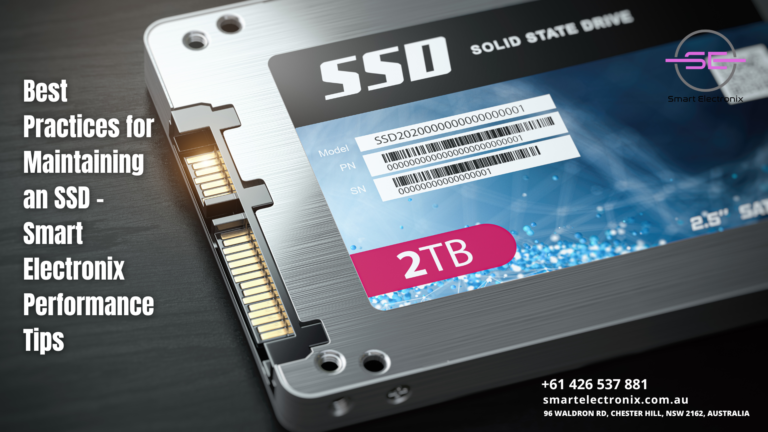
Ever wondered why your SSD doesn’t perform the same after a few months of use? You’re not alone. At Smart Electronix, we often get questions from users wondering how to keep their solid-state drives running at peak performance. Whether you use an SSD for gaming, work, or casual browsing, understanding how to maintain it properly can extend its life and save you from costly replacements.
In this blog, we’ll walk you through essential tips and performance strategies to ensure your SSD stays fast, reliable, and efficient for the long haul.
Why SSD Maintenance Matters
SSDs are much faster and more durable than traditional hard drives. However, they still require proper care. Unlike HDDs, SSDs have a limited number of write cycles. Ignoring best practices can result in performance drops, data corruption, or drive failure.
Maintaining your SSD doesn’t have to be complicated. A few simple habits can keep your drive in top shape while improving system responsiveness and data safety.
1. Enable TRIM Command
TRIM is a critical command that tells your SSD which blocks of data are no longer in use and can be wiped clean. Without it, the SSD won’t know which files are obsolete, leading to slower write speeds.
How to check TRIM status on Windows:
fsutil behavior query DisableDeleteNotify
A result of 0 means TRIM is enabled. If not, it can be activated via Command Prompt.
2. Avoid Full Capacity Usage
Leaving 15–20% of your SSD free is essential for wear leveling and background tasks. When storage is maxed out, SSDs slow down significantly and degrade faster.
Smart Electronix Tip: Periodically review and remove unnecessary files or shift them to cloud storage to free up space.
3. Do Not Defragment
Unlike HDDs, SSDs do not benefit from defragmentation. In fact, defragmenting an SSD can shorten its lifespan. Instead, let your OS optimize it automatically.
Windows Tip:
- Go to
Drive Properties - Click on
Tools>Optimize - Ensure it’s set to optimize the SSD automatically
4. Keep Firmware Updated
SSD manufacturers regularly release firmware updates that improve stability and speed. Check the official website of your SSD brand for updates and tools.
 Warning: Only download firmware from trusted sources. Smart Electronix always recommends checking compatibility before updating.
Warning: Only download firmware from trusted sources. Smart Electronix always recommends checking compatibility before updating.
5. Disable Indexing for SSDs
Search indexing creates unnecessary write operations. Disabling it for your SSD can reduce write load and extend longevity.
To disable indexing:
- Right-click your SSD drive
- Select
Properties - Uncheck “Allow files on this drive to have contents indexed”
6. Adjust Page File and Hibernation Settings
Page file and hibernation modes can create large hidden files that eat up SSD space and write cycles. If you have enough RAM, consider reducing or moving the page file to a secondary drive.
Disable Hibernation Command (Windows):
powercfg -h off
7. Use a UPS (Uninterruptible Power Supply)
Unexpected power loss can corrupt data on your SSD. A UPS provides protection against sudden shutdowns, especially during firmware updates or data transfers.
8. Install SSD Monitoring Software
Tools like CrystalDiskInfo or Samsung Magician allow real-time monitoring of SSD health, temperature, and lifespan.
Smart Electronix Suggests: Run monthly health checks and monitor wear levels to catch problems early.
9. Use Quality Accessories and Cables
Poor-quality SATA cables or loose connections can disrupt data flow and damage the SSD. Use trusted brands and ensure all connections are firm and secure.
10. Backup Regularly
No drive is 100% fail-proof. Always back up important files using reliable cloud services or external drives.
 Pro Tip from Smart Electronix: Automate backups weekly to avoid data loss.
Pro Tip from Smart Electronix: Automate backups weekly to avoid data loss.
Final Thoughts
Maintaining your SSD doesn’t require technical expertise—just smart habits. From enabling TRIM to using monitoring tools, these practices can help you enjoy a faster and longer-lasting storage experience. At Smart Electronix, we help users get the most from their devices with trusted repair services and expert tips.
For more SSD advice or diagnostics, visit Smart Electronix.
